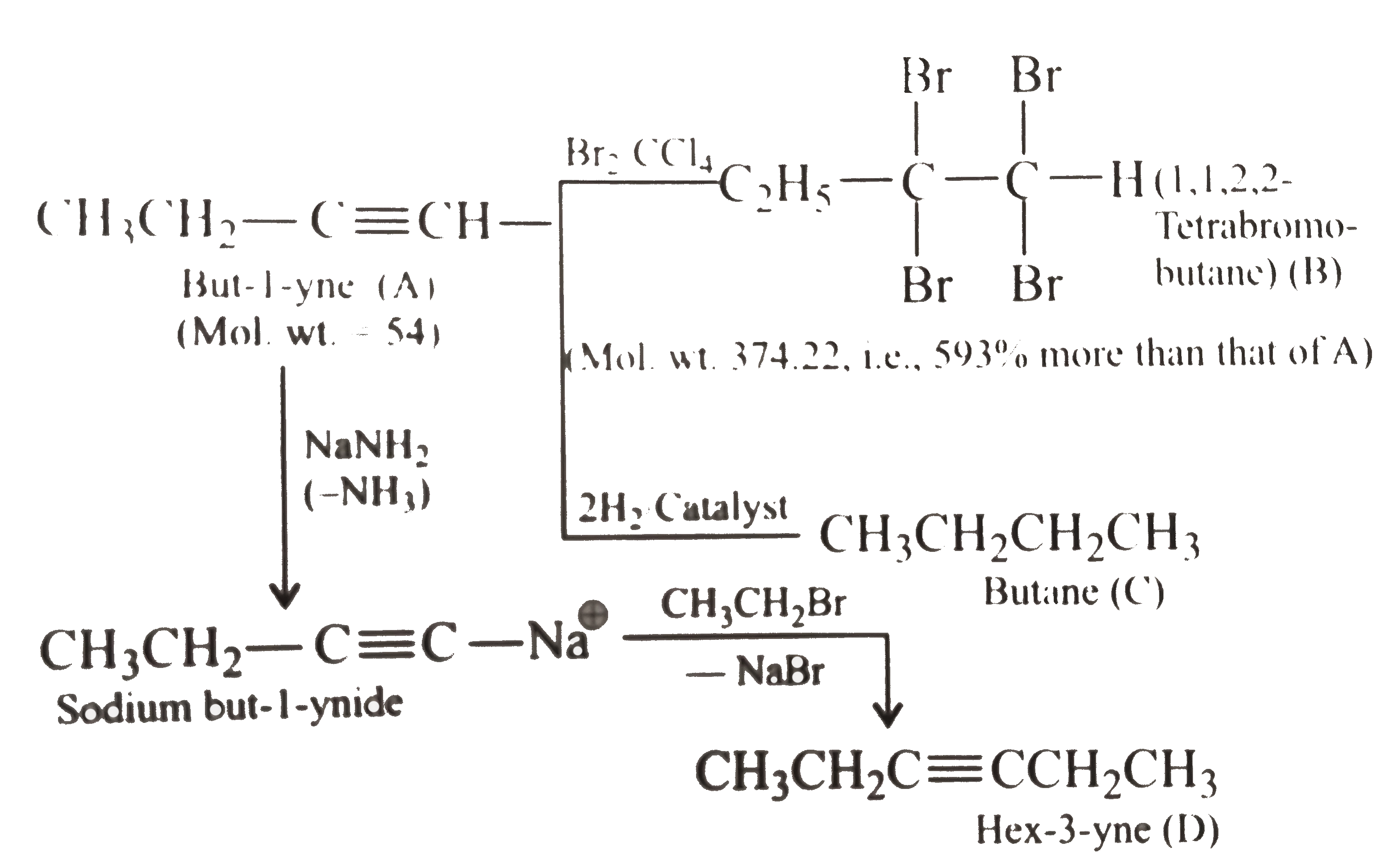A hydrocarbon (A) of molecular weight 54 reacts with an excess of Br2 in Cl4 to give a compound (B) whose molecular weight is 593% more than that of (A). However, on catalytic hydrogenation with excess of hyrogen (A) forms (C) whose molecular weight is noly 7.4% more that that of (A). (A) reacts with CH3CH2Br in the presence of NaNH2 to give another hydrocarbon (D) which on ozonolyisis yields kiketone (E). (E) on oxidation gives propionic acid. Give the structure of (A) to (E) with reason.
step 1. to determine the molecular weights of compounds (B) and (C)
(i). The molecular weight of compound (A) is 54 while that of compound (B), which it gives on treatment with an excess of Br2 in CCl4, is 593% more than that of (A).
Molecular weight of (B)=(100+593)100×54=374.22
Thus the increase in weight due to the adiiton of Br atoms is 374.22−54.0=320.22
Since atomic weight of Br is 80, the number of Br atoms added =320.2280=4. As such the hydrocarbon (A) must be an alkyne.
(ii). Further since the molecular weight of compound (C) which hydrocarbon (A) gives on catalytic hydrogenation, is only 7.4% more than that of (A). The molecular weight of (C) is
(100+7.4)×54100=57.994=58(approx)
Thus, the increase in weight due to the addition of H atoms =58−54=4.
Since the atomic weight of H is 1 the number of H atoms added during catalytic hydrogenation is 41=4. Therefore, hyrocarbon (A) must be an alkyne.


Topper's Solved these Questions
- PURIFICATION OF ORGANIC COMPOUNDS AND QUALITATIVE AND QUANTITATIVE ANALYSISBOOK - CENGAGE CHEMISTRYCHAPTER - PURIFICATION OF ORGANIC COMPOUNDS AND QUALITATIVE AND QUANTITATIVE ANALYSISEXERCISE - SOLVED EXAMPLES
17 Videos
- PURIFICATION OF ORGANIC COMPOUNDS AND QUALITATIVE AND QUANTITATIVE ANALYSISBOOK - CENGAGE CHEMISTRYCHAPTER - PURIFICATION OF ORGANIC COMPOUNDS AND QUALITATIVE AND QUANTITATIVE ANALYSISEXERCISE - Subjective Type
11 Videos
- PERIODIC CLASSIFICATION OF ELEMENTS AND GENERAL INORGANIC CHEMISTRYBOOK - CENGAGE CHEMISTRYCHAPTER - PERIODIC CLASSIFICATION OF ELEMENTS AND GENERAL INORGANIC CHEMISTRYEXERCISE - Exercises (Archives )Subjective
4 Videos
- REDOX REACTIONSBOOK - CENGAGE CHEMISTRYCHAPTER - REDOX REACTIONSEXERCISE - Archives (Integers)
1 Videos
Similar Questions
A hydrocarbon (A) of molecular weight 54 reacts with an excess of Br2 in Cl4 to give a compound (B) whose molecular weight is 593% more than that of (A). However, on catalytic hydrogenation with excess of hydrogen (A) forms (C) whose molecular weight is only 7.4% more that that of (A). (A) reacts with CH3CH2Br in the presence of NaNH2 to give another hydrocarbon (D) which on ozonolyisis yields diketone (E). (E) on oxidation gives propionic acid. Give the structure of (A) to (E) with reason.
View SolutionA compound having molecular formula C5H10O5 was reacted with excess of CH3COCl to give a compound having molecular weight 318 gm. Predict the number of hydroxy groups present into the unknown compound.
View Solution
Knowledge Check
Lower molecular weight optically active ether is reacted with cold HI gives
Abutan-1-ol and iodomethaneBbutan-2-ol and iodomethaneCpropan-1-ol and iodoethaneDpropan-2-ol and iodoethaneA organic compound contains 4% sulphur. Its minimum molecular weight is
A200B400C800D1600An organic compound contains 4% sulphur. Its minimum molecular weight is:
A200B400C800D1600
A hydrocarbon with lowest molecular weight has only one chiral carbon. Find its molecular weight.
View SolutionA hydrocarbon with lowest molecular weight has only onne chiral carbon. Find its molecular weight.
View SolutionA organic compound contains 4% sulphur. Its minimum molecular weight is
View SolutionThe vapour of a hydrocarbon is 2.47 times heavier than that of oxygen. What is its molecular weight ?
View SolutionThe empricial formula of a compound is CH2O. Its molecular weight is 120. The molecular formula of the compound is
View Solution
